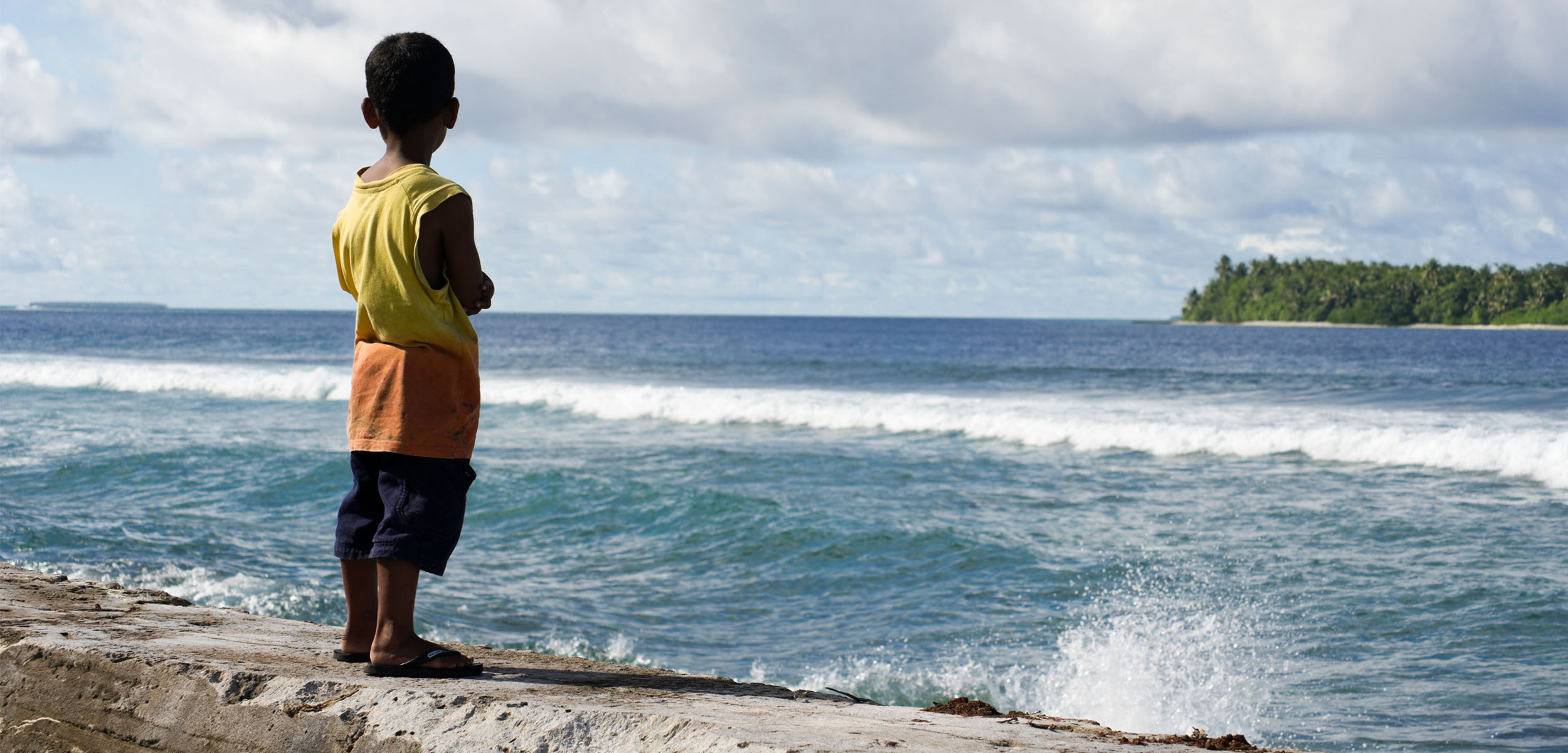The Marshall Islands Aren’t Giving In to Sea Level Rise
The precariously placed island nation has put together a comprehensive—if expensive—plan to survive sea level rise.
Article body copy
This article provides an update to the story “Landlocked Islanders,” published in 2015, which examined whether rising sea levels caused by anthropogenic climate change would force residents of the Marshall Islands away from the lands and waters they’ve inhabited for millennia.
Landlocked Islanders
Can Marshall Islanders whose lives are tied to the sea maintain their culture in Oklahoma?
To say that the Republic of the Marshall Islands is vulnerable to sea level rise is an understatement. Two million square kilometers of Pacific Ocean surround the country’s smattering of islands and tiny atolls, most of which are less than two meters above sea level. Since 1993, the surrounding ocean has risen by more than 12 centimeters; today, it regularly floods some neighborhoods, fields, roads, and even graveyards.
And this is just the beginning. If glaciers and polar ice sheets continue melting at the current rate—which is likely, even if global carbon emissions are capped—climate scientists expect the ocean around the Marshall Islands to rise as much as 1.3 meters by the year 2100. Powerful storms and extra big waves could temporarily push it even higher. Without drastic intervention, much of the country could be rendered uninhabitable.
Yet rather than succumb to this watery threat, the 80,000 or so citizens of the Marshall Islands are emerging as global leaders in climate adaptation. In December 2023, at the United Nations Framework Convention on Climate Change (COP28) in the United Arab Emirates, the Marshall Islands unveiled a National Adaptation Plan that experts say is the world’s most comprehensive to date.
“I was really impressed by how detailed the Marshall Islands’ plan was,” says Michael Gerrard, an environmental lawyer at Columbia University in New York. Since the United Nations established a process for creating National Adaptation Plans in 2010, more than 50 countries have crafted blueprints to guide the kind of medium- and long-term planning needed to respond to a warming planet. Most of these plans, however, tend to be fairly general. They “do not set forth a systematic pathway for decision-making in the coming decades,” Gerrard says.
The Marshall Islands’ 200-plus-page report, on the other hand, outlines a clear, multiphase “pathway for survival” that details exactly how the nation will respond as the ocean rises. Uniquely, it also includes the insights and opinions of more than 1,350 Marshall Islands citizens. These interviews illuminate a common theme: most islanders have no intention of fleeing. Of those surveyed, 99 percent rejected the idea that adapting to climate change means leaving their country.“Leaving is not in my thoughts,” says Alson Kelen, a Marshallese expert in traditional navigation and canoe building who attended COP28. “I’m not ready to think that way. Everybody [here] wants to pick up the torch and fight climate change and try to hang on as long as we can.”
This sense of agency will be vital as Marshall Islands citizens embark on an unprecedented journey to protect their ties to water, land, and sky—connections that have persisted for millennia through natural disasters, colonization, and nuclear testing.

From 1946 to 1958, the United States tested 67 atomic bombs in the Marshall Islands. Nuclear explosions permanently damaged some islands, forcing residents to move. Photo by mccool/Alamy Stock Photo
The country is already working to implement the first phase of its plan. In Majuro, the capital, workers are fortifying the low-lying airport, and officials are raising money and making plans to relocate government buildings to higher ground. In the rural outer islands, residents are building sea walls and creating fishing cooperatives and marine protected areas. Their goal is to strengthen communities against not only sea level rise but also drought, food insecurity, and other impacts of climate change.
The second phase of the adaptation plan, slated to begin around the year 2040 (or whenever the seas have risen by half a meter), essentially calls for atoll triage. Officials will decide which atolls to protect and then allocate resources to those places. People living elsewhere will either have to fend for themselves or move to these new centers.
Beginning around the year 2070, Marshallese leaders hope to protect at least four islands (or parts of islands) that can shelter the country’s entire projected population from substantial sea level rise. This might mean dredging sand from the ocean floor to construct artificial islands, as the Maldives has done, or raising the land of certain natural islands by up to 3.6 meters. Either way, it will be expensive. The adaptation plan estimates that raising just one area of land sufficient for the nation’s current population to live on in close quarters would cost around US $5-billion. Protecting four islands, then, could run upward of $20-billion.
Of course, there’s a big difference between having a plan and being able to pull it off. While the United Nations has a dedicated pot of money, called the Green Climate Fund, to help poorer nations pay for adaptation projects, Gerrard doubts the Marshall Islands will be able to secure enough funding to prevent a mass exodus.
“I don’t see anything that leads me to believe that billions of dollars to fortify the islands is going to be forthcoming,” Gerrard says, “especially since, at the time when that’s going to be most needed, the United States and most other countries are going to be facing severe sea level rise and other problems on their own and will be more likely to save themselves.”
If the Marshall Islands can’t raise enough money or find adequate sites to shelter the population, or if actual sea level rise is higher than projected, the plan grimly outlines the fallback option: abandon the islands entirely.
Unlike citizens of other low-lying island nations, people from the Marshall Islands know where they’ll go: the United States. Partially in recompense for detonating 67 nuclear bombs in the Marshall Islands in the mid-20th century, a legal agreement between the two countries allows any Marshall Islands citizen to live and work in the United States indefinitely. Already, some 30,000 islanders have left their homeland for US shores—up from 7,000 just 25 years ago.
In the face of this seemingly existential threat, however, Kelen has found a silver lining: soaring pride in Marshallese culture. In recent years, he says, traditional practices like tattooing, sailing, and weaving have surged in popularity.
Young Marshall Islands citizens, even those who didn’t grow up on the islands, are interested in maintaining Marshallese cultural practices and speaking the language. Like the National Adaptation Plan, this, too, is a kind of resilience—a way of ensuring that Marshallese culture and identity will persist no matter where people find themselves living, whether on a rural outer island, an artificial urban island, or even in landlocked rural America.


